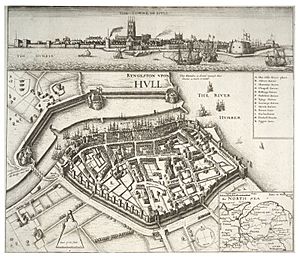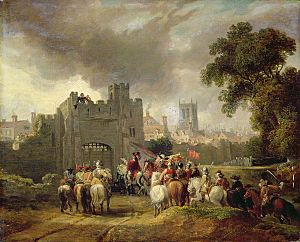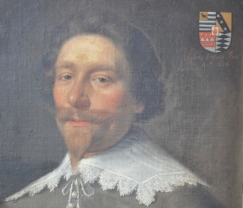Siege of Hull (1642) facts for kids
Quick facts for kids Siege of Hull |
|||||||
|---|---|---|---|---|---|---|---|
| Part of the First English Civil War | |||||||
 A map of Hull from c. 1640 |
|||||||
|
|||||||
| Belligerents | |||||||
| Commanders and leaders | |||||||
|
|||||||
| Strength | |||||||
| 3,000 infantry 1,000 cavalry |
1,500 soldiers | ||||||
The first Siege of Hull was a very important event that helped start the First English Civil War. It showed how serious the fight between King Charles I and Parliament had become. The King wanted to take control of a huge collection of weapons stored in Hull, a key town in East Riding of Yorkshire.
In April 1642, King Charles first tried to enter Hull, but the town's governor, Sir John Hotham, who supported Parliament, refused him entry. The King went back to York. However, in July, he heard that Hotham might be willing to give up the town if the King arrived with a large army. This would allow Hotham to surrender without looking weak.
So, King Charles marched towards Hull with about 4,000 soldiers. But Parliament had also sent help to Hull by sea. They were worried about Hotham's loyalty, so they sent Sir John Meldrum to help lead the town's defenses. Hotham again refused the King's demands to enter. The Royalists, led by the Earl of Lindsey (as the King had returned to York), started a siege. This siege wasn't very effective. Sir John Meldrum led several attacks from inside Hull. After a successful attack on July 27, which destroyed a Royalist supply area, the Earl of Lindsey ended the siege and pulled the King's forces back to York.
Contents
Why Hull Was Important
In 1642, there were big disagreements between the English Parliament and King Charles I. These arguments had been going on for over 50 years, about things like religion, money, and laws. In January 1642, King Charles tried to arrest five Members of Parliament (MPs) who were against him. He failed and realized that London supported Parliament more than him. So, Charles left the capital, and both sides started getting ready for war.
Hull's Importance and Defenses
In the 1600s, Hull was the second-largest town in Yorkshire, with about 7,000 people. Only York was bigger. Hull was very important for trade because it was on the North Sea. It was also where the River Hull and River Humber met, making it a center for trade within England. People called it a "very important town" and "strategically important."
Hull had the second-largest weapons storage in England, after the Tower of London. In 1642, it held 120 cannons, 7,000 barrels of gunpowder, and enough weapons for 16,000 to 20,000 soldiers.
The town was naturally easy to defend. It had strong walls built in the 1300s, which were made even stronger over time. By the 1630s, Hull was surrounded by walls. On the west side of the River Hull, there were medieval walls with a ditch and 25 towers. On the east side, a thick wall with three blockhouses had been built.
More improvements were made to the defenses before the Bishops' Wars. The ditch was cleaned, and another ditch was dug. New defenses were built between the ditches near the gates. Drawbridges were added, and the town got more cannons. Gates were also placed on the rivers to flood the low-lying land around the town, making it harder for attackers. One historian said Hull was "arguably the strongest fortress town in England."
Unlike most of Yorkshire, which had mixed support for the King or Parliament, Hull and the area around it strongly supported Parliament. Many people there were Puritans, who often disagreed with the King's religious views.
Sir John Hotham's Role
Sir John Hotham was a soldier who fought in the Thirty Years' War. Later, he became a Member of Parliament for Beverley. He was made governor of Hull in 1628. However, Hotham later opposed both the King and his chief minister, Thomas Wentworth. He was replaced as governor in 1639.
Hotham was known for getting offended easily. He felt insulted when he lost his positions, and he became a strong opponent of the King in Parliament.
Leading Up to the Siege
Because Hull had so many weapons, both the King and Parliament wanted to control it. On January 11, King Charles appointed the Earl of Newcastle as governor of Hull. Around the same time, Parliament gave Sir John Hotham the same job.
Newcastle tried to enter Hull on January 15, pretending to be someone else, but he was recognized. He couldn't get in because he didn't have enough soldiers or local support. Hotham's son, Captain John Hotham, arrived three days later with about 300 of his father's soldiers. He was also refused entry at first. But after threatening to tell Parliament and spreading rumors about attacks, he was finally allowed in.
At this time, it still seemed like the King and Parliament were working together. But this changed when King Charles moved north to York, about 35 miles from Hull, on March 18. He feared being captured if he stayed in the south. Around the same time, Sir John Hotham arrived in Hull to take over as governor. Parliament told him "not to admit any forces into Hull without orders from both houses of Parliament." The number of soldiers in Hull grew to about 1,000. Parliament was worried about the King's closeness, so they ordered most of Hull's weapons to be moved to London.
King Charles Demands Entry

King Charles wanted to get the weapons before they were moved. So, he rode towards Hull. He sent his eight-year-old son, the Duke of York, and his nephew, Charles Louis, ahead with some nobles and soldiers. They were allowed into Hull on April 22. The next morning, a messenger announced that King Charles planned to have dinner in the town that day.
Hotham met with the town's leaders. They decided not to let King Charles enter Hull. They closed the town gates and raised the drawbridges.
King Charles arrived at Beverley Gate on the morning of April 23 with many nobles and a large army. His messengers demanded entry, saying the arsenal belonged to the Crown. Hotham stood on the wall and explained that he could not let the King and his army in without breaking Parliament's trust. He said it would make him a "villain." He offered to let the King enter with a small group of twelve men. But when the King demanded thirty, Hotham refused, worried about Royalist supporters inside the town.
They argued until evening. Hotham did agree to send food for the King from the walls. Frustrated, the King called Hotham a traitor. But this had no effect, and the Royalists left for Beverley.
Parliament responded by saying Hotham was just following their orders. They said the King had broken Parliament's rules by calling Hotham a traitor. This made Hotham famous across the country. Parliament even published a speech Hotham made, and for a while, Parliament's supporters were called 'Hothamites'.
Hotham worried about people in Hull trying to betray the town. Parliament said that if he was killed, his son would take over as governor. To stop soldiers from leaving, Hotham spread rumors that the King would kill any soldiers caught outside the city walls. By the end of May, Parliament sent more leaders to Hull to help Hotham. During May, most of the weapons from Hull were moved by boat to London.
The Siege Begins
After refusing the King in April, Hotham had to stop several plots to betray Hull from inside the town. Some people believed Hotham was secretly planning to give the town to the King himself. A Royalist leader, Lord Digby, was captured by a Parliamentarian ship. He pretended to be a Frenchman who didn't speak English. He was taken to Hull, where he met Hotham and told him his real identity. Digby tried to convince Hotham to surrender Hull to the King. They agreed that if the King came with a large enough force, Hotham could pretend to resist before honorably surrendering. Digby then went to York, still disguised, and told King Charles the plan.
On July 3, King Charles marched from York with 3,000 foot soldiers and 1,000 horse soldiers. But when he arrived, Hotham did not let him in as planned. Hull's defenses had been made even stronger. The King's army was not well-trained or equipped enough to attack the town. Charles thought about blocking Hull, but he was told that the town was low-lying and had easy access to water. Also, Parliament controlled the navy, so Hull could easily get supplies by sea.
Parliament sent more soldiers, between 500 and 1,500, who arrived by sea on July 10. They were led by Sir John Meldrum. Meldrum was sent not only to add to the soldiers but also to command them, as Parliament doubted Hotham's loyalty. To make Hull even harder to attack, Hotham ordered the gates on the rivers to be opened. He also had the banks of the Humber River broken to flood the land around the town during high tide. He also ordered buildings outside the town walls to be destroyed so the King's army couldn't use them for cover. This included a hospital and a nearby village.
Even though Parliament controlled the navy, the Royalists managed to send one ship up the Humber River. They unloaded eight cannons and set up a battery (a group of cannons) on the east side of Hull. They also built forts in other towns to fire at ships on the river.
The siege of Hull officially began around July 10 or 15. An attack led by Meldrum is often called the "first blood" of the English Civil War. Meldrum attacked the King's forces with 500 men. The Royalist horse soldiers were not supported by their foot soldiers and ran away. Meldrum's forces chased them, killing two and capturing thirty.
At this early stage of the war, sieges in Britain were not very effective. King Charles, frustrated by his failure to capture Hull, left the town. He left the Earl of Lindsey in charge of his forces. Another attack by Meldrum on July 27 hit the Royalist weapons storage west of Hull. They captured fifteen cannons and a large mortar. After this loss, the Royalists ended the siege and went back to York.
What Happened Next
Less than a month after leaving Hull, on August 22, 1642, King Charles I raised his royal flag at Nottingham. He declared the Earl of Essex, and by extension Parliament, to be traitors. This officially started the First English Civil War.
Keeping Hull and its weapons was a huge win for Parliament. It meant their army started the war much better equipped than the King's forces. One historian called it "one of the pivotal actions" of the first year of the war.
In September 1642, Lord Fairfax, a Parliamentarian leader, made a peace agreement with local Royalists in Yorkshire. Hotham disagreed with this. He broke the agreement by attacking other towns in October. The Royalists then attacked Fairfax's headquarters. Hotham still had doubts about going against the King. He even tried to secretly switch sides and join the Royalists.
In June 1643, Captain Hotham was arrested for being disloyal but escaped. Parliament worried that both Hothams would betray them. So, they ordered Matthew Boynton to take control of Hull, which he did on June 29. Hotham escaped but was captured and taken to London. Both Hothams were sent to the Tower of London, tried, and sentenced to death. Despite efforts to save them, they were executed in January 1645.
In 1642, Parliament had the upper hand in the East Riding of Yorkshire. But they lost land the next year. By June 1643, they only held a few towns, including Hull. In August, a Royalist army of 16,000 men captured Beverley, forcing Sir Thomas Fairfax, Lord Fairfax's son, to retreat to Hull. The town was besieged again from September 2 to October 12. The Royalists attacked Hull with eighteen cannons. Even though the town was damaged, it was still supplied by sea. In early October, Parliamentarian attacks damaged or captured some of the Royalist forts. Along with a Royalist defeat in another battle, this made the Royalists end the siege and retreat to York.
See also
Images for kids






